You know that feeling when you walk into a kitchen and it just feels right? Like you could spend hours there cooking, chatting, or just sipping coffee while pretending you have your life together? That’s exactly what green and white kitchens do—they create this perfect balance between fresh, energizing vibes and cozy, welcoming warmth. I’ve been obsessed with this color combo lately, and honestly, it’s hard not to be. Green brings nature indoors without making your kitchen look like a jungle (unless you’re into that, no judgment :)), while white keeps everything bright and clean. Let me walk you through 15 gorgeous ways to make this color duo work in your kitchen.
Sage Green Cabinets with White Marble Tops
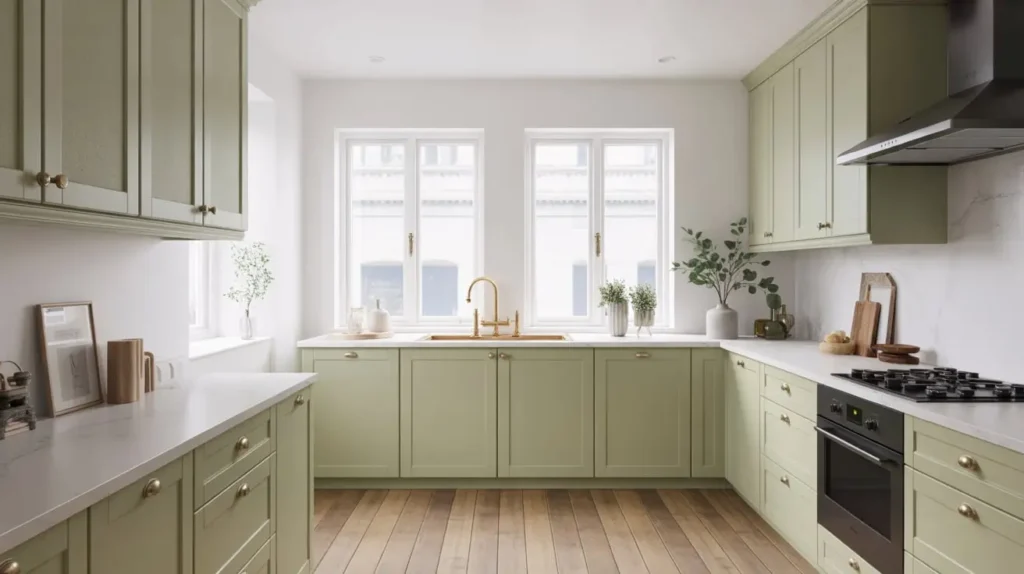
Listen, sage green is having a moment right now, and for good reason. This muted, dusty green shade screams sophistication without trying too hard. When you pair sage green cabinets with white marble countertops, you get this timeless look that somehow feels both classic and trendy.
I recently saw a kitchen renovation where someone switched from boring builder-grade oak to sage green Shaker-style cabinets, and the transformation was insane. The white marble (or even marble-look quartz if you’re budget-conscious like most of us) adds these beautiful veining patterns that catch the light and create visual interest.
Here’s why this combo works so well:
- The cool undertones in sage green complement the gray veining in white marble
- White countertops reflect light, making the space feel bigger
- Sage doesn’t overpower like brighter greens might
- It photographs beautifully (important for those of us who Instagram everything)
Want to elevate this look even more? Add brass or gold hardware to your sage cabinets. The warm metallic tones create this gorgeous contrast that makes the whole kitchen feel expensive, even if you DIY-ed half of it.
Two-Tone Green and White Shaker Kitchen

Two-tone kitchens are everywhere these days, and I’m not mad about it. Pairing green lower cabinets with white uppers (or vice versa) gives you the best of both worlds without committing fully to one color. It’s like having cake and eating it too, except it’s your kitchen and you don’t have to share.
The beauty of the Shaker style is its simplicity—those clean lines and recessed panels work with literally any design aesthetic, from traditional to modern. When you go two-tone with green and white Shakers, you create visual layers that add depth to your kitchen.
I love doing darker greens on the bottom and keeping the uppers white. Why? Because dark lower cabinets hide all those inevitable spills and scuffs better than white ever could (let’s be real), while white upper cabinets keep the space from feeling too dark or closed in.
Pro tips for nailing the two-tone look:
- Keep your color split at the natural break point (usually where countertops sit)
- Use the same hardware style throughout for cohesion
- Consider doing your island in the contrasting color for extra visual interest
- Paint color samples on large boards and look at them throughout the day—lighting changes everything
Mint Green Walls with White Open Shelving
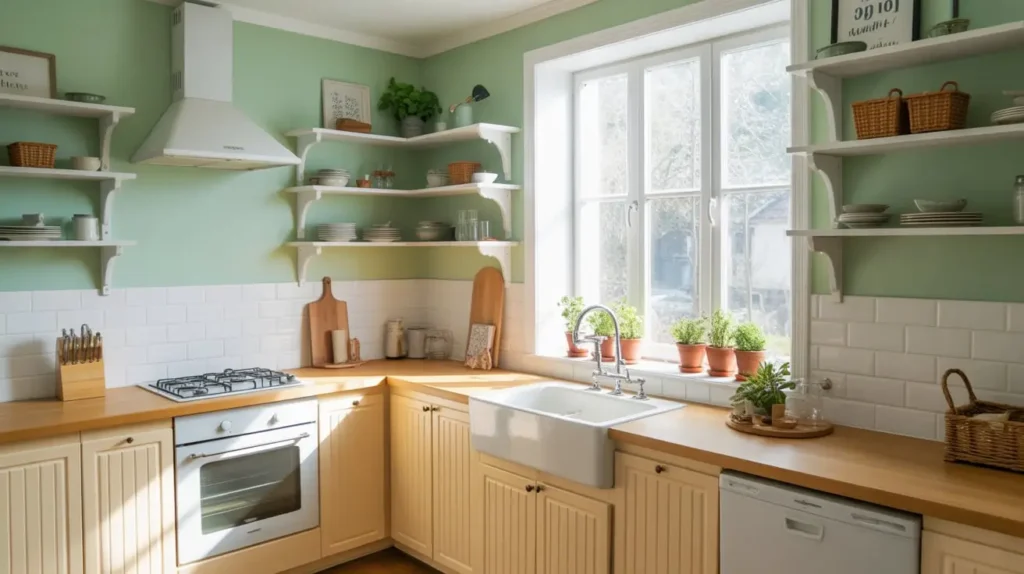
Here’s where things get fun and a little retro. Mint green walls instantly transport you to a 1950s diner, but in the best possible way. Pair those cheerful walls with white open shelving, and you’ve got yourself a kitchen that’s equal parts vintage charm and modern functionality.
I’ll be honest—open shelving isn’t for everyone. If you’re the type who accumulates random coffee mugs and mismatched dishes (guilty), those open shelves will expose all your secrets. But if you can commit to keeping things organized and aesthetically pleasing, the payoff is huge.
The mint and white combo shines because:
- Mint green is cheerful without being overwhelming
- White shelves pop against the colored walls
- Open shelving makes small kitchens feel more spacious
- You can easily switch out dishes and decor to update the look
FYI, if you’re worried about commitment, paint is literally the easiest thing to change. Start with mint walls and white cabinets, add open shelving where it makes sense, and see how you feel. You’re not signing a lease with your paint color :/
Forest Green Island in an All-White Kitchen

Want to make a statement without going all-in? A forest green island in an otherwise white kitchen is chef’s kiss. This approach gives you that pop of color right where you need it—at the centerpiece of your kitchen—while keeping everything else light and airy.
Forest green is bold, rich, and sophisticated. It’s the color that says “I know what I’m doing” even if you’re Googling how to properly season a cast-iron skillet. When you anchor an all-white kitchen with a deep forest green island, you create a focal point that draws the eye and grounds the space.
I’ve seen this done in both massive kitchens and smaller spaces, and it works beautifully in both. In a large kitchen, the green island prevents that sterile, overly clinical feeling that all-white spaces sometimes have. In a smaller kitchen, it adds personality without overwhelming.
Make your green island the star:
- Choose a darker forest green for drama
- Top it with white marble or butcher block
- Add statement lighting above the island (think brass pendants)
- Consider seating at the island to make it functional and social
- Use it as the only pop of color for maximum impact
Also Read: 15 Trendy Green and Wood Kitchen Ideas for Modern Homes
Olive Green Lower Cabinets with White Uppers

Olive green is having a renaissance, and honestly, it’s about time. This earthy, grounded shade brings serious warmth to kitchens, especially when you use it on lower cabinets and pair it with crisp white uppers.
The thing about olive green is that it has these complex undertones—sometimes it leans more gray, sometimes more brown, sometimes even a bit yellow depending on your lighting. This complexity makes it incredibly versatile and sophisticated.
When you do olive lowers and white uppers, you’re basically creating a kitchen that feels grown-up and put-together without being stuffy. The darker bottom cabinets visually anchor the space, while the white uppers keep things from feeling too heavy or dark.
Styling tips for this look:
- Use warm-toned wood flooring to complement the olive
- Stick with white or cream countertops
- Add greenery (real plants, please—fake ones always look fake)
- Consider a white subway tile backsplash for classic appeal
- Warm metallics like brass or copper work better than cool-toned chrome
This combination particularly shines in kitchens with lots of natural light. The white uppers reflect that light around the room while the olive lowers add richness and depth.
White Kitchen with Green Backsplash Accents
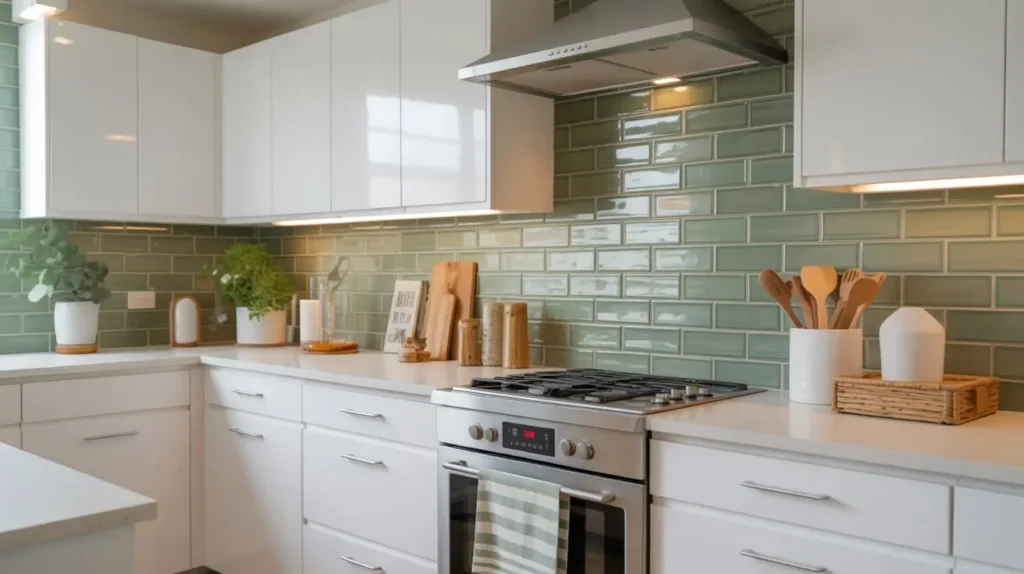
Maybe you’re not ready to commit to green cabinets—I get it. A white kitchen with green backsplash accents lets you test the waters without fully jumping in. Plus, backsplashes are way easier (and cheaper) to change than cabinets if you decide you hate it later.
I love this approach because it’s low-risk, high-reward. Your cabinets stay classic white, which means they’ll never go out of style, but you get that personality injection through your backsplash choice.
Green backsplash options that work beautifully:
- Sage green subway tiles arranged in classic brick pattern
- Forest green zellige tiles for that handmade, organic look
- Mint green glass tiles that reflect light gorgeously
- Hunter green picket tiles for a modern geometric vibe
- Patterned ceramic tiles with green and white designs
The beauty here is versatility. You can go bold with your green choice because it’s a smaller area, or keep it subtle with a soft sage. Either way, white cabinets provide the perfect neutral backdrop that lets your backsplash shine without competing for attention.
Green and White Farmhouse Kitchen Charm
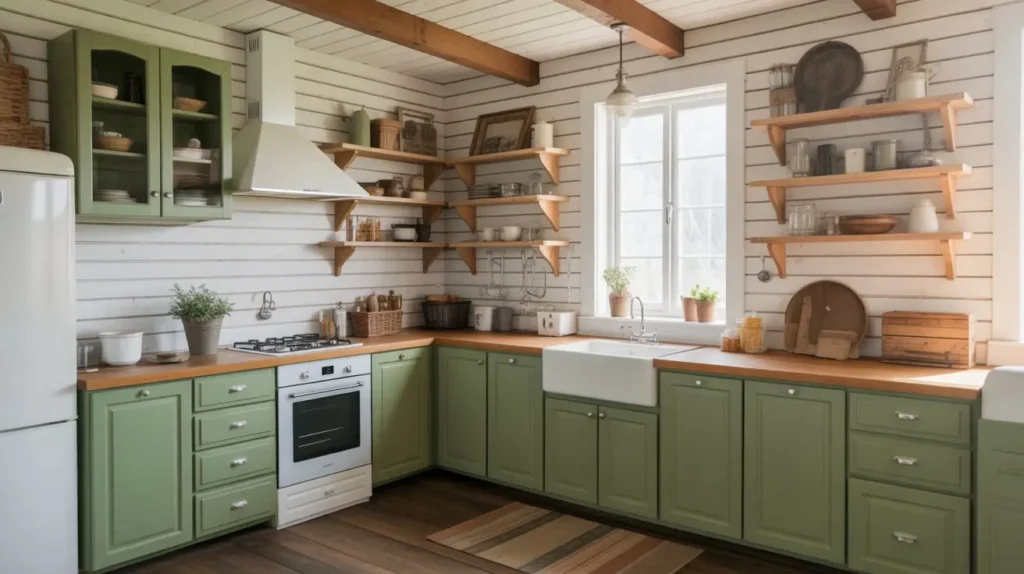
Farmhouse kitchens have this magical ability to feel both elegant and lived-in at the same time. When you add green and white to the farmhouse aesthetic, you get something truly special—a kitchen that feels like it belongs in a countryside cottage but somehow also looks magazine-worthy.
Think about classic farmhouse elements: apron-front sinks, open shelving, butcher block counters, vintage-style hardware, and shiplap (yes, we’re still doing shiplap, deal with it). Now add soft green tones and crisp white, and boom—you’ve got yourself a cozy, inviting space that makes you want to bake bread from scratch.
I recently visited a friend who renovated her kitchen in this style, and I literally didn’t want to leave. She did white shiplap walls, sage green lower cabinets, white uppers with glass fronts, and a massive white farmhouse sink. The whole space felt so warm and welcoming that we ended up hanging out in there all evening.
Essential elements for farmhouse green and white:
- Apron-front farmhouse sink in white
- Mixed metals (oil-rubbed bronze and brass work great)
- Open shelving displaying white dishes and greenery
- Wood accents like butcher block or reclaimed wood beams
- Vintage-inspired lighting fixtures
- Soft, muted greens rather than bright ones
The farmhouse style particularly suits those who want their kitchen to feel collected over time rather than decorated all at once. IMO, that’s what makes these spaces so appealing—they look like they have stories to tell.
Modern Minimalist Green and White Kitchen
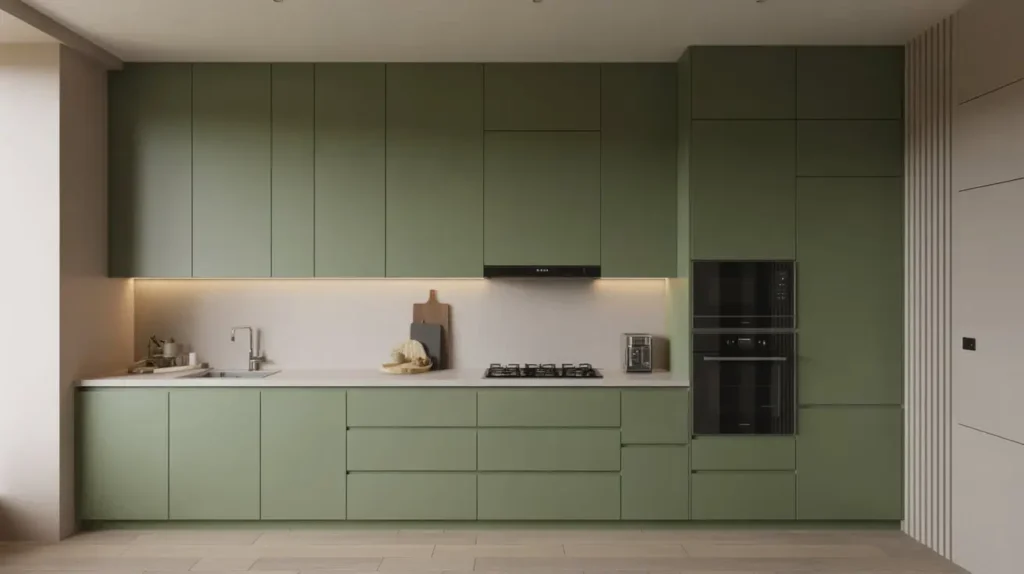
Now, if farmhouse isn’t your vibe and you’re more into clean lines and “less is more,” a modern minimalist green and white kitchen might be your perfect match. This style strips away the excess and focuses on functionality, quality materials, and intentional design choices.
Modern minimalist doesn’t mean boring—it means every element has a purpose and nothing is there just for show. When you incorporate green into a minimalist kitchen, you’re adding that essential warmth that prevents the space from feeling too cold or sterile.
Key features of minimalist green and white kitchens:
- Flat-panel or slab-front cabinets (no ornate details)
- Handleless cabinets with push-to-open mechanisms
- Monochromatic green tones, usually in muted shades
- White countertops in quartz or solid surface materials
- Hidden storage to maintain clean lines
- Integrated appliances that blend seamlessly
I love how this style forces you to be intentional about what you keep out. No random clutter, no unnecessary decorative items—just the essentials, beautifully designed. One designer I follow did a minimalist kitchen with matte olive green cabinets, pure white counters, and absolutely nothing on the countertops except a single olive tree in a white pot. Stunning.
The trick with minimalist design is investing in quality. When you don’t have decorative elements to hide behind, your materials and craftsmanship need to be top-notch.
Vintage Cottage Green and White Space

There’s something undeniably charming about vintage cottage kitchens. They feel cozy, quirky, and full of personality—like your grandmother’s kitchen but updated for modern living. Green and white is basically the color palette that cottage kitchens were born to wear.
Cottage style embraces imperfection and eclectic charm. You might mix different shades of green, combine various white tones, throw in some vintage finds, and somehow it all works together beautifully. It’s the opposite of matchy-matchy, and that’s exactly the point.
I’m obsessed with how forgiving this style is. Got an old hutch you painted mint green? Perfect. Found vintage green tiles at a salvage yard? Even better. Inherited your aunt’s collection of white ironstone? Display it proudly.
Creating vintage cottage green and white charm:
- Mix different shades of green rather than matching perfectly
- Incorporate vintage or vintage-style appliances (those retro SMEG fridges? Yes, please)
- Use beadboard or wainscoting painted white
- Display collections (white dishes, green glass, vintage kitchenware)
- Add floral patterns through curtains, tablecloths, or dish towels
- Include a vintage-style table and mismatched chairs
This style particularly shines in older homes where you can work with original architectural details. But honestly? You can create cottage charm anywhere if you embrace the eclectic, collected-over-time aesthetic.
Emerald Green Cabinets with White Countertops

Okay, emerald green is bold. We’re not playing around with soft, subtle shades here—emerald makes a statement, and that statement is “I have excellent taste and the confidence to show it.” When you pair rich emerald cabinets with pristine white countertops, you create serious drama in the best possible way.
Ever wondered why emerald works so well in kitchens? It’s because the color has this jewel-tone depth that photographs beautifully and looks expensive, even if you got your cabinets from IKEA and painted them yourself (which, honestly, is a totally valid approach).
The contrast between deep emerald and bright white is striking. White countertops act as a visual rest stop for your eyes between all that gorgeous green, preventing the space from feeling too dark or overwhelming.
Styling emerald and white successfully:
- Use it in kitchens with plenty of natural light (emerald can go dark in poorly lit spaces)
- Pair with warm-toned metals like brass or gold
- Keep walls white or very light gray
- Add plants to echo the green tones
- Consider glass-front upper cabinets in white to break up solid emerald
- Use white or light-colored flooring
I’ve seen emerald kitchens that make me want to completely redo my own space. There’s one in particular with emerald lowers, white marble counters, brass hardware, and white subway tile that lives rent-free in my head. It’s that good.
Green Tile Backsplash with White Cabinets

We touched on this earlier, but green tile backsplashes deserve their own spotlight because the options are truly endless. This is where you can get creative, experimental, and maybe a little wild with your design choices while keeping the rest of your kitchen safely in white territory.
The beauty of focusing your green on the backsplash is that it’s a manageable amount of color. You get that personality and visual interest without committing to green cabinets, which some people find intimidating (no judgment—kitchen renovations are expensive and scary).
Tile options that’ll blow your mind:
- Zellige tiles: Handmade Moroccan tiles with that gorgeous uneven glaze that catches light beautifully
- Subway tiles: Classic, affordable, and available in every shade of green imaginable
- Geometric patterns: Hexagons, arabesques, picket shapes in various greens
- Mosaic tiles: Tiny tiles creating patterns or color gradients
- Large-format tiles: Fewer grout lines, more modern aesthetic
- Patterned cement tiles: Bold designs incorporating green and white
I recently helped a friend choose tiles for her backsplash, and we spent hours looking at samples. She ended up going with these gorgeous sage green zellige tiles, and they completely transformed her basic white kitchen. The handmade quality adds so much character that you’d never know her cabinets are stock from a big-box store.
Pro tip: Order extra tiles. Seriously, order like 15-20% more than you think you need. Tiles get discontinued, batches vary in color, and things break. Future you will thank present you.
Also Read: 15 Gorgeous Green Kitchen Island Ideas and Dreamy Designs
Soft Pistachio Green Kitchen with White Decor
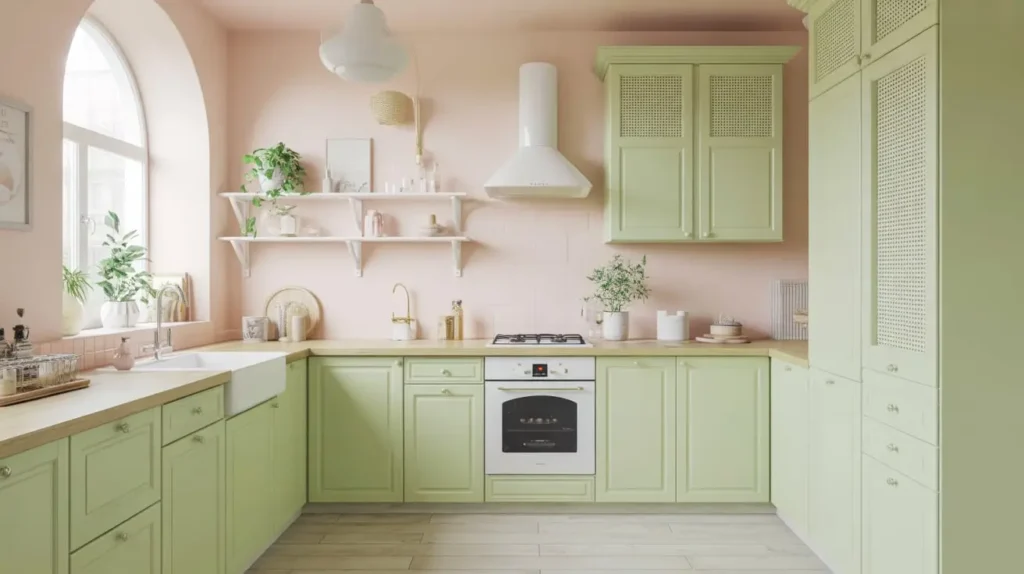
Pistachio green is sweet, soft, and surprisingly versatile. It’s lighter than sage, warmer than mint, and has this almost creamy quality that makes kitchens feel incredibly inviting. When you build a kitchen around soft pistachio and punctuate it with white decor, you create a space that feels fresh but never harsh.
This color works particularly well if you want a green kitchen but worry about it feeling too dark or too bold. Pistachio is gentle—it doesn’t demand attention, but it definitely gets noticed in the best way.
Making pistachio green work:
- Use it on cabinets for all-over color
- Or paint walls pistachio and keep cabinets white
- Layer in white through dishes, countertops, and decor
- Add natural wood tones for warmth
- Include cream or ivory accents rather than stark bright white
- Bring in greenery and natural textures
I love how pistachio feels both retro and current at the same time. It has that vintage vibe without feeling dated, and it’s having this moment in design right now where it shows up in everything from kitchens to bathrooms to living rooms.
The key to pulling off pistachio is embracing its softness. Don’t try to make it edgy or modern—let it be the gentle, welcoming color it is, and style accordingly.
Rustic Green Wood Kitchen with White Beams

Want to bring serious character to your kitchen? Rustic green wood paired with white exposed beams creates this cabin-meets-cottage vibe that’s absolutely irresistible. This style works beautifully in homes with existing architectural features like beamed ceilings, but you can also add beams for that instant rustic appeal.
Picture this: reclaimed wood cabinets painted in a weathered green, white-painted ceiling beams, maybe some brick or stone accents, and lots of natural materials throughout. It’s cozy, it’s warm, and it makes you want to cook a big pot of soup while wearing a chunky sweater.
The rustic approach is all about texture and natural materials. You’re not going for polished perfection here—you want things that feel handcrafted, lived-in, and authentic.
Essential rustic elements:
- Reclaimed or distressed wood cabinets in muted green
- Exposed white ceiling beams (real or decorative)
- Stone or brick backsplash
- Open shelving with chunky wood shelves
- Farmhouse sink
- Vintage-style or industrial lighting
- Mixed metals with a weathered finish
This style particularly suits homes in rural areas, mountain locations, or anywhere you want that cozy cabin feeling. But honestly? I’ve seen rustic green and white kitchens in suburban homes and city apartments that work beautifully because they bring that sense of nature and craftsmanship indoors.
Coastal Green and White Kitchen Serenity

Coastal kitchens should feel like a beach house, even if you’re landlocked in the middle of nowhere. Soft, watery greens paired with crisp white create that breezy, relaxed vibe that makes you feel like you’re on permanent vacation.
The key to coastal style is keeping things light, bright, and airy. You want your kitchen to feel like ocean breezes could blow right through it (even if you’re actually just running the AC because it’s July and you’re sweating).
Think seafoam green, aqua-tinted sage, or pale celadon paired with lots of white. The green shades should remind you of sea glass, ocean waves, or coastal vegetation—nothing too dark or heavy.
Coastal kitchen must-haves:
- Light, watery green tones
- Plenty of white throughout
- Natural textures like rattan, jute, or linen
- Glass elements (glass-front cabinets, glass tiles, glass accessories)
- White or light wood flooring
- Chrome or nickel hardware (cool-toned metals work best)
- Nautical touches used sparingly (we don’t need anchors everywhere)
I stayed at a beach rental last summer with the most perfect coastal kitchen—white shiplap walls, glass-front cabinets painted this gorgeous pale aqua-green, white marble counters, and these amazing rattan pendant lights. I took about a hundred photos for “inspiration” (read: kitchen envy).
The beauty of coastal style is how relaxed and unpretentious it feels. Nothing too precious, nothing too formal—just easy, breezy, beautiful.
Dark Green and White Kitchen with Brass Touches

Let’s end with some serious sophistication, shall we? Dark green—think hunter, British racing, or deep forest—paired with white and brass creates a kitchen that looks like it belongs in a design magazine. This combination is elegant, timeless, and undeniably luxe.
Dark green cabinets make a bold statement, but when you balance them with white counters, white walls, or white uppers, and then add warm brass hardware and fixtures, you get this perfect trinity of colors that just works.
I’m obsessed with this trend because it brings that moody, dramatic vibe without going dark and depressing. The white keeps things balanced, and the brass adds warmth and that touch of glamour that elevates everything.
Nailing the dark green, white, and brass look:
- Use dark green on lower cabinets or all cabinets if you’re brave
- White marble or quartz countertops are essential
- Brass hardware on all cabinets and drawers
- Brass faucets and lighting fixtures
- Consider a brass range hood for serious impact
- Keep walls white to prevent the space from feeling too dark
- Add plenty of lighting (under-cabinet, pendant, recessed)
This style works particularly well in kitchens with high ceilings or lots of natural light. Dark green can feel heavy in small, poorly lit spaces, but in the right setting with adequate white and brass to balance it? Absolutely stunning.
One thing I’ve learned: invest in quality brass fixtures. The cheap stuff tarnishes quickly and looks dinky. Get unlacquered brass that develops a beautiful patina over time, or go with PVD-finished brass that stays shiny forever. Your future self will thank you when your kitchen still looks amazing years from now.
Bringing It All Together
Here’s the thing about green and white kitchens—they work for literally everyone. Whether you want something soft and subtle like pistachio, bold and dramatic like emerald, or somewhere in between with sage or olive, there’s a green shade that’ll make your heart happy. And white? White is the ultimate team player, making every shade of green look its absolute best.
You don’t need a massive budget or a complete gut renovation to bring green and white into your kitchen, either. Start small: paint your cabinets, add a green backsplash, switch out hardware for brass, or even just incorporate green through decor and accessories. Sometimes the smallest changes make the biggest impact.
The beauty of this color combination is its versatility. Green and white can go farmhouse or modern, coastal or rustic, minimalist or maximalist, vintage or contemporary. It adapts to whatever style speaks to you while always maintaining that fresh, cozy vibe that makes kitchens feel like the heart of the home.
So whether you’re planning a full renovation or just daydreaming about your future kitchen (guilty as charged), I hope these 15 ideas sparked some inspiration. Green and white kitchens have this magical quality—they feel both energizing and calming, both sophisticated and approachable, both timeless and current. And honestly? That’s exactly what a great kitchen should be.





